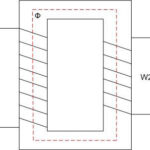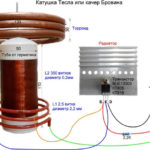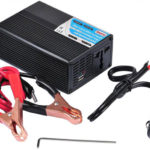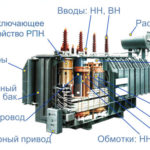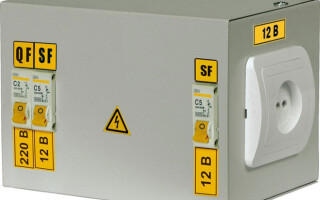Without this electrical device, consumers of electricity would not be able to charge car batteries, connect energy-saving light sources. An electrical product lowers the stationary voltage to the required level. The device is made on the basis of electromagnetic induction. Sold in specialized stationary trade enterprises, online stores.
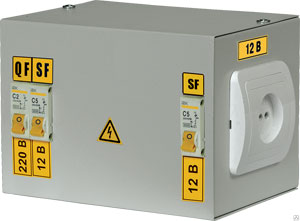
Content
General device and principle of operation
A step-down transformer from 220 to 12 volts is bought by drivers, summer residents, owners of country houses, cottages for building an in-house low-voltage lighting network. At times, the use of 220 volt electrical power in the home is not economically rational.
The product consists of four main parts: two core rods and two coils of copper wire of the required section and length. They are called windings containing an unequal number of turns.Core rods are made of special steel used in the electrical industry. The transformer 220 is supplied with the current of the stationary electrical network.
In the primary winding, an intensive movement of electrons begins, an electromotive force is created. A magnetic field is formed, crossed by the second winding. Electric potentials appear in it, since the magnetic field of the first coil causes self-induction (the movement of electrons) into the second one. There is a difference in electrical levels, tending to equalize the potential values to zero.
The transfer of electrons from a high potential to a final zero creates an electric current. The voltage in the secondary winding depends on how many times it has fewer turns than in the first. It should be remembered that a step-down electrical device generates an alternating voltage in the terminal winding with a polarity change of 50 times per second. They also receive direct current by connecting a rectifier to the system in order to have 12 volts of direct current at the output.
There is a wide range of electronic step-down products that do not contain cores, coils.
Step-down devices are microscopic electronic circuits coupled with capacitors, resistors, and other important elements. They have undeniable advantages over traditional current converters, which are:
- in compactness;
- in weight;
- in manual undervoltage control;
- in silent operation;
- in high efficiency.
The buyer can choose the transformer he needs. This is his right.
It is recommended to operate a self-made transformer by hiding it behind the walls of a metal or wooden case with natural ventilation.
How to choose a step down transformer
Imported electrical appliances powered by 110 volts appeared on sale. Domestic electrical networks supply current with a voltage of 220 volts. It is problematic to use a foreign household or other device. But there is a way out. You can purchase a 220 transformer with 110 volt step-down terminals.
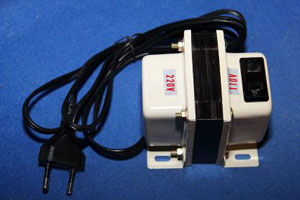
When choosing a step-down product, it is important to calculate the maximum load for which it is designed. The result is obtained by the following method. Multiply volts by current to get power. The formula looks like this: V x A=W. A powerful consumer of electrical energy is selected, the peak load is calculated using the formula, and 20% is added to its value.
Let's take an example. A housewife purchased an imported food processor powered by a 110 volt network, designed for a current of 3 A. We multiply the indicators. We get the power of 330 W. This is the standard power at which the combine operates. But during the preparation of a dressing, for example, for borscht, a bone got into the combine, which the device must grind. In a second, the power will jump to 1400 W. The manufacturer of electrical appliances in the technical data sheet indicates the maximum power.
A device that lowers the current is easy to make yourself. The algorithm of actions is as follows: the number of turns of metal wire on the coils is counted. The calculation of the primary begins with a winding of 220 volts. After calculations, the number of turns is determined. 2200 turns are obtained with a wire cross section of 0.3 mm and a rod area of 6 square meters. cm.
After that, the number of turns for a 12 volt coil is calculated.The second coil, producing a voltage of 12 volts, will have 120 turns with a wire cross section of 1 mm. The number of turns of one winding should not be equal to the other. Ideally, they can, if the copper wire is of different sections.
A voltage of twelve volts feeds LED strips, lamps, halogen lighting. Halogen lamps require little power. An important point is the manufacture of the core. The power of the transformer depends on its quality.
If there is no special electrical steel at hand, metal containers from beer, bread kvass, and other liquid products are used. Strips 3 dm long and 0.2 dm wide are cut from cans. The workpieces are fired, after which scale deposits are removed. Lacquered, wrapped with paper on one side.
The second winding is filled with wires with a cross section of 1 mm. The reel base is made of high strength cardboard material. Wrap the cardboard blank with paraffin-impregnated paper. Wire is wound on the prepared cores, not forgetting to separate the wound turns with paper. Ready-to-use windings are fixed on a compact wooden or metal frame. Fix with staples or other fasteners.
Step-down transformer connection diagram
How to connect a 220 to 12 volt transformer is of interest to many. Everything is done simply. Suggests the algorithm of actions marking at the connection points. The output terminals on the connection panel with the contact wires of the consumer device are marked in Latin letters. The terminals to which the neutral wire is connected are marked N or 0. The power phase is marked L or 220. The output terminals are marked 12 or 110.It remains not to confuse the terminals and answer the question of how to connect a step-down transformer 220 with practical actions.
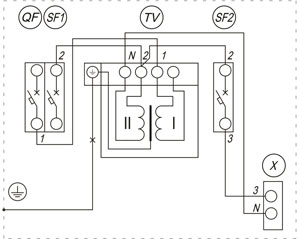
The factory marking of the terminals ensures safe connection by a person who is not familiar with such actions. Imported transformers pass domestic certification control and do not pose a danger during operation. Connect the product to 12 volts according to the principle described above.

Now it’s clear how a factory-made step-down transformer is connected. It is more difficult to decide on a homemade device. Difficulties arise when, during the installation of the device, they forget to mark the terminals. To make the connection without error, it is important to learn how to visually determine the thickness of the wires. The primary coil is made of wire of a smaller section than the end-action winding. The connection scheme is simple.
It is necessary to learn the rule according to which it is possible to obtain a step-up electrical voltage, the device is connected in the reverse order (mirror version).
The principle of operation of a step-down transformer is easy to understand. It has been empirically and theoretically established that the coupling at the level of electrons in both coils should be estimated as the difference between the magnetic flux effect that creates contact with both coils and the electron flux that occurs in a winding with a smaller number of turns. By connecting the terminal coil, it is found that a current appears in the circuit. That is, they receive electricity.
And here there is an electrical collision. It is calculated that the energy supplied from the generator to the primary coil is equal to the energy directed into the created circuit. And this happens when there is no metal, galvanic contact between the windings.Energy is transferred by creating a powerful magnetic flux with variable characteristics.
In electrical engineering there is a term "dissipation". The magnetic flux along the route loses power. And that's bad. The design feature of the transformer device corrects the situation. The created designs of metal magnetic paths do not allow the dispersion of the magnetic flux along the circuit. As a result, the magnetic fluxes of the first coil are equal to the values of the second or almost equal.
Similar articles:


